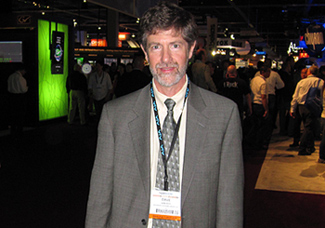NAB 2011: Industry Continues to Move Toward File-Based Workflows
by Dave Van Hoy
LAS VEGAS—If you spent any time on the show floor at the 2011 NAB Show last month, one trend was very clear: Tape is dead. Sure, tape is thriving as an archive platform – with new products from companies like Quantum and FOR-A on display at the show – but when it comes to acquisition, broadcasters and other content creation professionals have clearly embraced the migration to file-based workflows. That said, facilities are still struggling to find the best way to organize these ever-growing libraries of information.

It’s very easy for video assets to get out of control quickly. Think of your file-based storage system as a garage. It’s easy to find what you want when your garage is tidy and only holds a few items. As you collect more and more stuff, however, you’re not sure where you put certain things, and it’s difficult to decide what to discard (or even where to start). And did you remember to label everything so that it’s easy to pinpoint what you need without searching through several similar boxes?
Unfortunately, the broadcast industry can’t universally adopt media management techniques from other industries. Banks, for example, have asset management down to a science, but transactions like deposits and withdrawals aren’t open to interpretation like video or audio assets. How would you identify a low-angle shot that shows busy foot traffic on a city sidewalk? Would every other producer in your station use the same words in the file metadata?
Asset management remains a problem for broadcasters, but the solution is less about which system you use and more about how you deploy it. At NAB, there were more vendors than ever with asset management solutions, and most emphasized the importance of planning. It’s important to realize that today’s asset management systems tend to be either “production process” or “final deliverable” oriented. Very few systems do both well.
Decide which type of system is right for your workflow and that will lead you to the appropriate vendors. Perhaps most importantly, you must make a deployment plan and train your personnel – and make sure they buy into the asset management concept – or the deployment is destined to fail, no matter which solution you choose.
One of the asset management “hits” of the show came from Square Box Systems, a smaller U.K.-based company in the South Hall. Its CatDV entry-level, Mac-based asset management system is simpler to deploy than some of the more established systems and has a lower price point. The company has been exhibiting at NAB for years and received some industry awards in 2010, but attendees really seemed to take notice this year, as the need for affordable asset management systems seems to be reaching a critical mass.
I also learned from speaking with other attendees that the original concept of “collaborative workflow,” where editors work simultaneously on the same editing project from different workstations, is only important in episodic television production and some feature films. It turns out the vast majority of video professionals just don’t work that way. Instead, projects are passed between departments or personnel.
For these distributed work environments, an asset management system is essential. You need to keep track of content and have some sort of method to check out and check in assets. Also, you’ll need to accelerate the transfer of large files over the Internet, as many collaborators are not located in the same facility. Standard FTP is very slow, so file transfer acceleration tools, such as the Aspera family of products, are essential. Plus, you’ll want a review and approval toolset. It can be as simple as a low-res file attached to an e-mail or as sophisticated as an Internet-based review and approval tool like ScreenLight.
Finally, an unavoidable topic at NAB was the continuing expansion of content delivery methods. Tools for delivering video content to consumers continue to expand at a very rapid pace, which is creating new opportunities and tremendous challenges for broadcasters. Your nightly newscast and Web site might be excellent, but in the near future, they may not be enough to keep your audience, which is becoming more and more mobile.
I have seen local TV stations rebuilding production facilities that have been dormant for years, because they have to produce more content – content that they own and is locally relevant – to draw in and capture audiences. The retransmission of network content is becoming less relevant (and profitable) for local stations, because the same programs are available through other channels, such as video-on-demand and the Internet. Instead, in addition to traditional news and other local programming, I expect to see broadcasters producing more short-format content in an effort to engage mobile viewers.
Dave Van Hoy is president of Advanced Systems Group, one of the largest installers of post production and shared storage systems on the West Coast. Contact him at dvh@asgllc.com.
Get the TV Tech Newsletter
The professional video industry's #1 source for news, trends and product and tech information. Sign up below.
